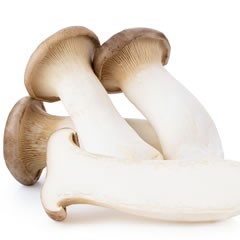Mushrooms
 Mushrooms are estimated to be grown on 85 farms throughout the state with a value of $4.3 million each year. New York State ranks tenth in the country for mushroom production (2022 Census of Ag).
Mushrooms are estimated to be grown on 85 farms throughout the state with a value of $4.3 million each year. New York State ranks tenth in the country for mushroom production (2022 Census of Ag). Many types of mushrooms can be grown. Most mushrooms grown in our region of New York are Shiitake or Oysters, both considered "specialty mushrooms" by the USDA. These mushrooms are grown in a variety of outdoor, indoor, and hybrid systems including on logs, in the ground, in raised beds, or in blocks contained in buckets or plastic bags. Crops are sold fresh, dry, powdered, or incorporated into value-added products.
Relevant Events
2025 Potato Advisory Meeting
December 16, 2025
Canandaigua, NY
2026 Finger Lakes Produce Auction Winter Growers Meeting
January 8, 2026
Penn Yan, NY
Things to Consider When Adding Specialty Mushrooms to Your Farm
Lori Koenick, Extension Support Specialist
Cornell Vegetable Program

Let's set aside the familiar button, cremini, and portabella mushrooms (all in the same species of Agaricus mushrooms) and focus on a different and growing segment of the mushroom industry: specialty mushrooms. The USDA defines "specialty mushrooms" as any non-Agaricus mushroom, which includes Shiitake, Oyster, Lion's Mane, and many more.
Specialty mushroom production benefits include new income sources, crop diversification, utilization of unused space or waste streams, and building soil health. These mushrooms are grown in a variety of low-cost ways in outdoor, indoor, and hybrid systems including on logs, in the ground, in raised beds, or in blocks contained in buckets or plastic bags.

Upcoming Events
2025 Potato Advisory Meeting
December 16, 2025
Canandaigua, NY
Come hear the latest on insect pest control and fertility management in potatoes from Cornell University experts. Potato variety trial updates will be shared too. After lunch will be the Empire State Potato Grower's Meeting. 1.5 DEC credits in 10, 1a, and 23.
2026 Finger Lakes Produce Auction Winter Growers Meeting
January 8, 2026
Penn Yan, NY
At this vegetable grower-focused meeting, ag industry experts will discuss food safety, disease management in strawberries, the benefits of using cover crops, plus more. Two grower panel discussions will focus on pest management techniques and irrigation. DEC recertification credits offered in categories 10, 1a, 21, 22, 23, and 24.


































